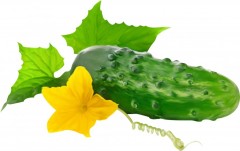 |
100 grams of cucumbers contain 15 kcal.
Protein: 0.8 g
Fat: 0.1 g
Carbohydrates: 2.8 g
|
Cucumber (Cucumis sativus) belongs to the pumpkin family. Its closest relatives are pumpkin, melon, and zucchini. It consists of 95-97% water and in this regard, many have the opinion that there is no benefit from cucumbers - only water. There really is a lot of water, but:
- In addition to water, this vegetable contains many organic substances that play an important role in metabolism. They improve digestion and promote better absorption of other foods.
- Without exaggeration, cucumber water can be called “magical.” This is a perfectly structured liquid that has a healing effect on all organs and systems. The famous promoter of a healthy lifestyle, Paul Breg, argued that it is cucumber juice that actively removes all poisons and toxins from the body.
- Largely due to the high water content, this product is low in calories, only 15 calories per 100 g of weight. You can eat it as much as you like without fear of gaining excess weight.
How many calories are in one cucumber?
On average, one cucumber weighs 100-120 grams, therefore, it contains 15-18 kcal.
For comparison:
Calorie content of other vegetables
| product | how many calories per 100 g |
| zucchini | 24 kcal. |
| tomato | 20 kcal. |
| potato | 77 kcal. |
| eggplant | 24 kcal. |
| carrot | 32 kcal. |
The energy value of fresh cucumbers is not much different from the calorie content of salted cucumbers and is:
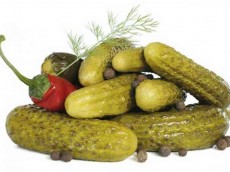 |
Salted ones have 11 kcal. Lightly salted - 12 kcal. Pickled - 16 kcal. |
How many calories are in cucumber salads?
| names of salads | how many calories per 100 g of product |
| cucumber salad with herbs and vegetable oil | 55-90 kcal. |
| cucumber and tomato salad with olive oil | 90-100 kcal. |
| cabbage and cucumber salad with olive oil | 40 kcal. |
| cucumber with sour cream | 45 kcal. |
Chemical composition of cucumber
The tables indicate the content of minerals and vitamins contained in 100 grams of the product, as well as the daily requirement of an adult for these minerals and vitamins.
Amount of microelements
| microelements | quantity | daily requirement |
| iron | 0.6 mg. | 18 mg. |
| iodine | 3 mcg. | 150 mcg. |
| manganese | 0.18 mg. | 2 mg. |
| cobalt | 1 mcg. | 10 mcg. |
| selenium | 0.3 mcg. | 55 mcg. |
| molybdenum | 1 mcg. | 70 mcg. |
| copper | 100 mcg. | 1000 mcg. |
| fluorine | 17 mcg. | 4000 mcg. |
| zinc | o.22 mg. | 12 mg. |
| chromium | 6 mcg. | 50 mcg. |
| aluminum | 425 mcg. | — |
Number of macronutrients
| macronutrients | quantity | daily requirement |
| calcium | 23 mg. | 1000 mg. |
| potassium | 141 mg. | 2500 mg |
| sodium | 8 mg. | 1300 mg. |
| magnesium | 14 mg. | 400 mg. |
| phosphorus | 42 mg. | 800 mg. |
| chlorine | 25 mg. | 2300 mg. |
What vitamins are contained in cucumbers?
Although cucumbers are 95% water, they contain no less vitamins than other vegetables.
| names of vitamins | quantity | daily requirement |
| vitamin A | 10 mcg. | 900 mcg. |
| vitamin B1 | 0.03 mg. | 1.5 mg. |
| vitamin B2 | 0.04 mg | 1.8 mg. |
| vitamin B4 | 6 mg. | 500 mg. |
| vitamin B5 | 0.27 mg. | 5 mg. |
| vitamin B6 | 0.04 mg. | 2 mg. |
| vitamin B9 | 4 mcg. | 400 mcg. |
| vitamin C | 10 mg. | 90 mg. |
| vitamin E | 0.1 mg. | 15 mg. |
| vitamin H | o.9 mcg. | 50 mcg. |
| vitamin K | 16.4 mcg. | 120 mcg. |
| vitamin PP | 0.3 mg. | 20 mg. |
| beta carotene | 0.06 mg | 5 mg. |
Nutritional value of cucumbers
| calorie content | 15 kcal. | 1684 kcal. |
| squirrels | o.8 g | '76 |
| fats | 0.1 g. | 60 |
| carbohydrates | 2.5 g. | 211 |
| alimentary fiber | 1 g | 20 g |
| water 95 g | 95 g | 2400 g |
| organic acids | 0.1 g | — |
| ash | 0.5 g |
How many cucumbers can you eat per day?
Cucumber is a tasty, healthy and low-calorie product. Healthy people can use it without restrictions. If you have problems with the heart, kidneys or gastrointestinal tract, then any diets should be discussed with your doctor.
Is it possible to freeze cucumbers for the winter?
Cucumbers not only can, but also need to be frozen for the winter. This is usually done for two purposes:
- cosmetic
- culinary
For cosmetic purposes, it is most convenient to cut into circles. The circles are cut 3-5 mm thick, then be sure to dry them on a towel. After this, we lay out our mugs on a board or cardboard and place them in the freezer. Only the next day, the already frozen cucumbers can be put into a container for further storage.
If you immediately pour fresh cucumber slices into a bag or container and freeze them in this way, they will freeze in one large piece and then it will be impossible to separate them.
You can try to decorate holiday dishes with such round slices in winter, but you must keep in mind that after defrosting, cucumbers will no longer have such an attractive appearance as fresh vegetables.
As practice has shown, frozen cucumbers performed best in okroshka. Thawed vegetables will neither crisp nor please the eye with their appearance. But the cucumber aroma and taste is fully preserved.
For winter okroshka, cucumbers are either cut into small cubes or simply grated on a coarse grater. To avoid having to break a large frozen piece later, immediately put the mixture into bags in small portions.
All this will not take you much time, and okroshka in winter will be just as tasty and aromatic as in summer.
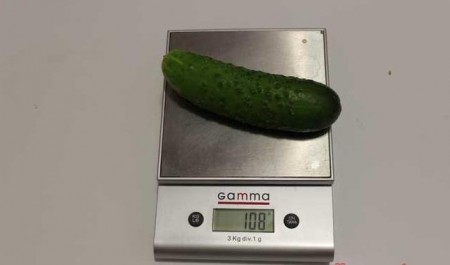
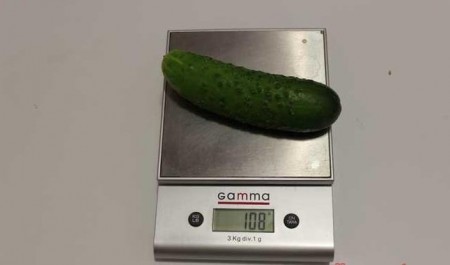
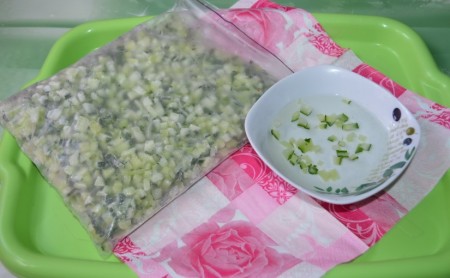

 CUCUMBERS NEVER GET SICK, I'VE BEEN USING ONLY THIS FOR 40 YEARS! I SHARE A SECRET WITH YOU, CUCUMBERS ARE LIKE THE PICTURE!
CUCUMBERS NEVER GET SICK, I'VE BEEN USING ONLY THIS FOR 40 YEARS! I SHARE A SECRET WITH YOU, CUCUMBERS ARE LIKE THE PICTURE! You can dig a bucket of potatoes from each bush. Do you think these are fairy tales? Watch the video
You can dig a bucket of potatoes from each bush. Do you think these are fairy tales? Watch the video
 How our fellow gardeners work in Korea. There is a lot to learn and just fun to watch.
How our fellow gardeners work in Korea. There is a lot to learn and just fun to watch. Eye trainer. The author claims that with daily viewing, vision is restored. They don't charge money for views.
Eye trainer. The author claims that with daily viewing, vision is restored. They don't charge money for views. A 3-ingredient cake recipe in 30 minutes is better than Napoleon. Simple and very tasty.
A 3-ingredient cake recipe in 30 minutes is better than Napoleon. Simple and very tasty. Therapeutic exercises for cervical osteochondrosis. A complete set of exercises.
Therapeutic exercises for cervical osteochondrosis. A complete set of exercises. Which indoor plants match your zodiac sign?
Which indoor plants match your zodiac sign? What about them? Excursion to German dachas.
What about them? Excursion to German dachas.